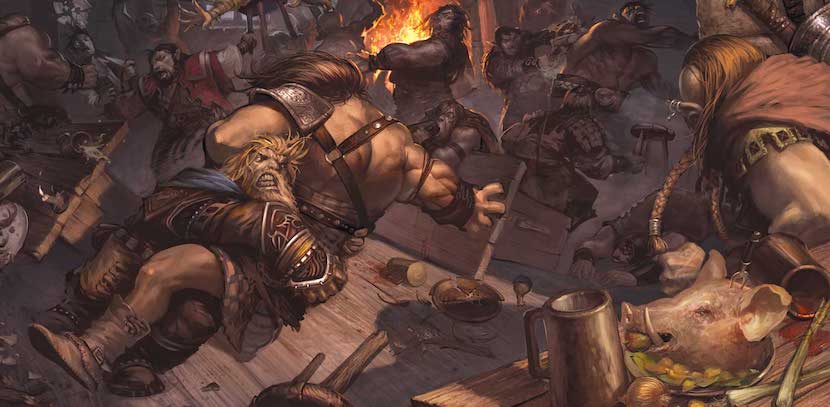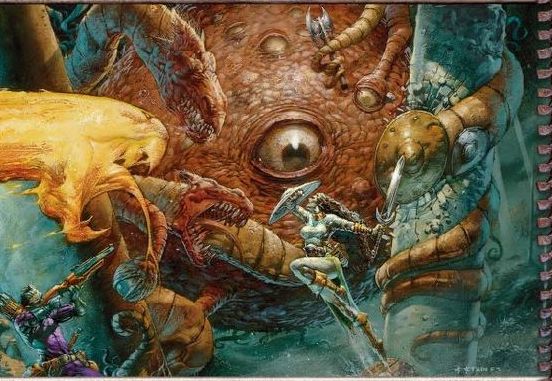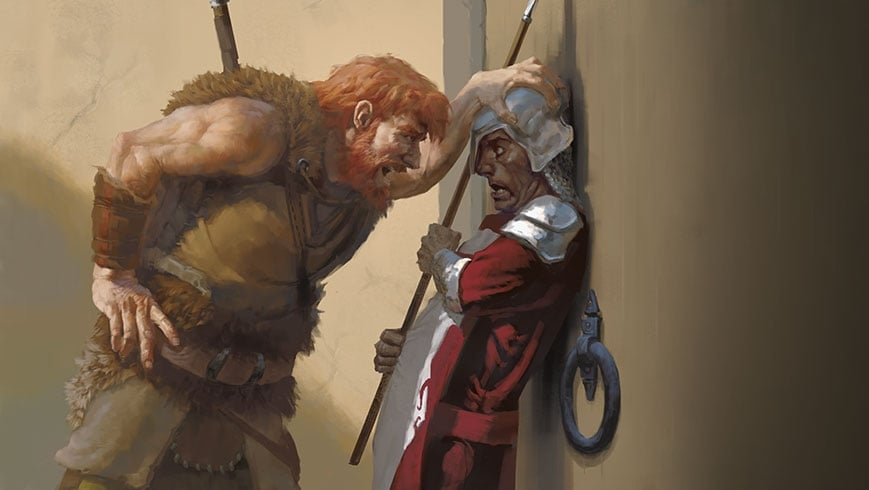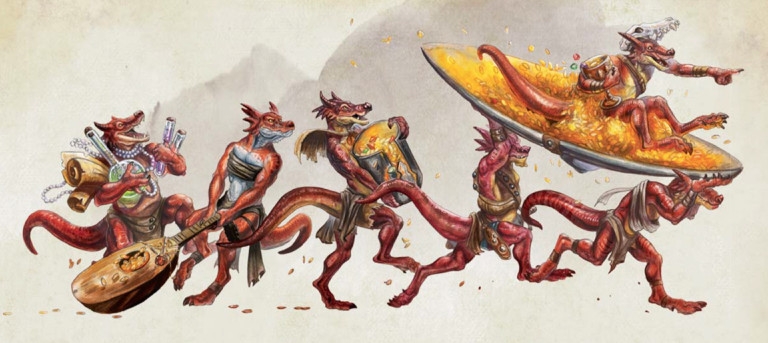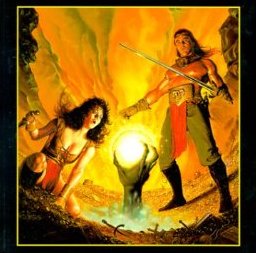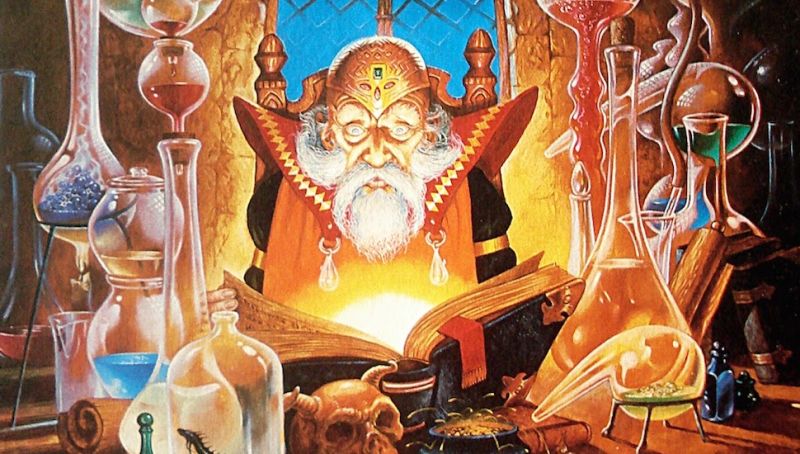RPG: Playing Up Your Roleplaying


Want to add more R to your RPG? Here are a few things you can use to draw some character out of your player characters.
Roleplaying can add some depth and immersion to your game–it can be a source of banter, player ownership, all kinds of fun things that make your game better. Sure, sometimes all you want to do is kill the troll in the next room, but a big part of the fun of that is figuring out who your characters are while they kill the troll. So let’s talk about how you can bring that out a little more. A few touches here and there can help even the hackinest, slashiest sessions take on a little extra life of their own.
Some types like bar brawls, other people like tavern tussles…
The first big thing you can do is look for opportunities to engage your players. You want to find a hook–maybe an interesting NPC or a curious item that’s relevant to one of the players–basically you want something to grab their attention and then give them permission/encouragement to roleplay. It may sound strange to think of someone needing permission to roleplay, but in social situations we’re always trying to suss out the group dynamic, like a bunch of middle schoolers waiting to figure out that it’s okay to ask someone to dance. I like to think of it as creating space in your adventures for roleplaying to happen.
After all, there are plenty of adventures that create space for combat to happen. It’s what the majority of the rules are there for–heck it’s what makes up the bulk of any adventure. Go out there and thumb through a dungeon crawl, and you’ll find room after room of fighting. And sure you’ll probably also encounter some puzzles and story elements, and places where the characters have to use their noncombat skills, but those aren’t necessarily roleplaying encounters. Nor does having combat preclude it from being a roleplaying encounter.
Because any character can roleplay, points in persuasion or not. So how do you create space for roleplaying to happen? How do you engage your players? I like to think in terms of encounters. So let’s go with that. If you’re building a roleplaying encounter, you’ve got a few basic goals in mind. Where in a combat encounter, your goal might be “have the monsters deal HP damage to the players,” and they’ve got the tools of their attacks, in a roleplaying encounter your goal is “get the player to think about something in-character.” Because once you do that, even just a little, it breathes life into the game.
Get Personal
So with that in mind, take stock of your players. Is there a fighter? A wizard? A cleric of a particular deity? Did one of your players write a too-elaborate backstory that you looked at briefly while eating a sloppy joe, and now you’re not sure if they’re a lost heir to the throne, or if they lost the heir to the throne?
Wait I thought you meant you were playing someone who fought AGAINST Beholders when you said “Beholder Fighter…”
Basically you want to look for things you can use to specifically target your players’ characters. This can be something as simple as having someone take notice of a specific action they’ve done in the past. So the adoring townsperson whose cabbages were saved from orcish doom thanking the fighter (or better yet, being excited about something the fighter did) can be a great roleplaying encounter. You have the farmer mention something specific: “I’ve never seen anyone swing a sword like that! Was it hard, fighting them orcs?” and by making it skew a little positive, you’ve right away given a little nugget of encouragement that makes the player feel good about themselves and prompts them to respond.
And voila, you’ve gotten someone to think about something in character. You’ve asked them a question that doesn’t have a rules answer, and that may well have no right answer, and because you’re offering them some positivity, you may well be starting a connection between these characters.
Pictured: ‘Connection’
Another example is asking them personal philosophy sort of questions. “What do you think about the king’s decision?” Or “what do you think is at the heart of this darkness?” “Ill-omens on the wind, wouldn’t you say?” That sort of thing. With these you’re trying to get the players to answer in line with their characters. And stuff like this is super low-stakes. It probably won’t alter the outcome of the adventure to answer any of these questions, but it does place a little bit of focus on the characters. And because you’re giving them the spotlight with such low stakes, you’re tacitly giving them permission to play a little. Because the answer is personal there isn’t necessarily a wrong answer, so it’s less of an on-the-spot kind of moment, which a lot of times will free up even the most deer-in-the-headlights player.
And also by having the NPCs take notice/interest of what the players think you’re creating room–and encouraging–players to likewise take notice.
Decision-Making
Another trick I have found is creating moments for players to make decisions. Once you’ve gotten them used to the idea of thinking about what their character would think (hoo boy), the next step up is giving them a chance to apply that. This is where it gets a little complicated. So when I say make decisions, I mean specifically for them to make a choice that has no clear right answer. But that has something that, by picking it, indicates that it’s something the players want.
It’s kind of like completing a quest in a video game and getting a choice of rewards–but, where the video game might offer you three different swords that suit three different playstyles (and one of the swords is an axe, let’s say), you’re looking to offer something that doesn’t necessarily have a direct comparison. After all, the fighter picking the magic two-handed sword, after he’s spent the last few levels getting better at two-handed strikes isn’t really a choice. It’s just logical.
‘What are we going to do with your share of the treasure’ is a perfectly valid question if the answer isn’t “buy a slightly better magic sword.”
Buuut, that same fighter having to decide who to take on as an apprentice: the shy young stablehand who dreams of adventure, or the wisecracking thief who stole his purse, that’s a purely character-driven decision. It appeals to the characters’ sensibilities… there’s no real right answer here. After all the trick you want is to reward them either way–“hey you’re getting a follower who can help you do stuff” so the distinction carries little mechanical meaning, but still matters to the character.
It’s harder to do when there’s a mechanical benefit to the decisions–but you can try things like having two or more groups task the players with a mutually exclusive objective. Like two separate groups asking the players to retrieve the same item from a dungeon. A Wizard and a Druid might both want the same magic orb–they’ll put it to different uses. And depending on who they help, the players get advantage on the next arcana or nature check they make, depending on who they helped.
Look, sometimes magic just comes in orb form, okay? Best not to question it…
The key with mechanical rewards like this, is to keep them distinct, to keep them temporary, and to set it up so that the players feel as though their decision mattered. So, if the players picked the arcana check boost, you’d be remiss not to give them a hard arcana challenge later–but they don’t have to know that the challenge didn’t matter. It’s all about getting them to think in character.
If you really want to get tricky with this, then maybe think about ways they can feel both rewarded for making their choice, but also to see how making the other choice might have benefitted them. So for instance, retrieving the magic orb and giving it to the druid makes them have an easier time with nature stuff–and as a result every now and then they come up against some difficult arcana threat (representing the road not taken). It’s a quick way you can imply that their decisions matter–you’re showing consequences, but not necessarily punishing the players for doing something.
Deep Impact
That last point leads me right into our final trick for today. When you can, try and make it feel like the decisions your players have made have some kind of impact on the game. This isn’t necessarily a big thing, like, they saved the town and now the townspeople are happy (although that’s always good). But–have characters come to them looking for advice–and then find little moments later on where they can see how their advice has paid off. Let them see that that brash young thief apprentice has taken to becoming more of a swashbuckler. Or that the couple they encouraged to talk to one another are falling in love.
Basically you’re looking for things the characters have touched–if I see my players looking a little more engaged I try and take notes as to what they’re into–and then finding ways to bring them back. It reinforces the idea that their decisions matter while at the same time helping to build an internal consistency for your world.
Anyway, these are just a few of the many ways you can start encouraging your players to roleplay. And for the people who already like to roleplay, you can use these tricks to create some space in your game to have more moments for those players to get to shine. I hope these help, and as always, feel free to share any tricks that work for you.
Happy Adventuring!

